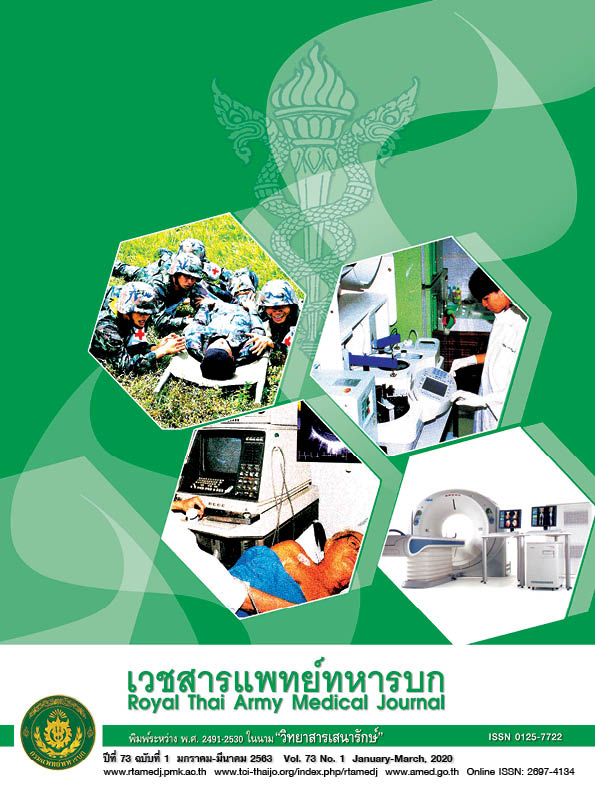Surgical Outcomes of Laparoscopic Sacrocolpopexy and Sacrohysteropexy for Apical Prolapse Repair
Main Article Content
บทคัดย่อ
วัตถุประสงค์ เพื่อศึกษาถึงผลลัพธ์ อัตราการกลับเป็นซ้ำและภาวะแทรกซ้อนของการผ่าตัดแก้ไขภาวะอุ้งเชิงกรานหย่อนส่วนบนด้วยวิธีผ่านกล้องโดยใช้ตาข่ายยึดช่องคลอดกับเอ็นกระดูกสันหลัง วิธีการศึกษา เป็นการศึกษาแบบวิเคราะห์เปรียบเทียบย้อนหลังจากบันทึกในประวัติของคนไข้โรคอุ้งเชิงกรานหย่อนตั้งแต่ระยะที่ 2 เป็นต้นไปซึ่งได้มารับการผ่าตัดด้วยวิธีผ่านกล้องโดยใช้ตาข่ายยึดช่องคลอดกับเอ็นกระดูกสันหลังทั้งแบบตัดมดลูกและเก็บมดลูก ตั้งแต่เดือน กรกฎาคม พศ. 2556 ถึง มิถุนายน พ.ศ. 2558 ที่คาเมดะ เมดิคอล เซ็นเตอร์ ประเทศญี่ปุ่น การผ่าตัดทำโดยแพทย์เฉพาะทางด้านนรีเวชระบบทางเดินปัสสาวะเพียงท่านเดียว ในรายที่ตัดมดลูกจะทำการตัดแบบเก็บปากมดลูกไว้ก่อนใช้ตาข่ายยึดช่องคลอดกับเอ็นกระดูกสันหลัง ตาข่ายที่ใช้จะเป็นชนิดที่นำมาตัดแต่งเอง ข้อมูลของคนไข้ที่นำมาวิเคราะห์ได้แก่ ปัจจัยทางประชากร การประเมินคนไข้ก่อนผ่าตัด(POP-Q) ข้อแทรกซ้อนในขณะผ่าตัดและผลลัพธ์ของการผ่าตัด อัตราความสำเร็จทางกายวิภาคคือ ตำแหน่งของจุด Aa Ap และ C อยู่เหนือต่อ เยื่อพรหมจารีใน 1 ปีของการตรวจติดตามคนไข้ ผลการศึกษา คนไข้จำนวนทั้งสิ้น 59 รายอายุเฉี่ย 62.8±9.1 ปี ใช้การผ่าตัดด้วยวิธีผ่านกล้องทุกราย ในจำนวน 59 ราย 43 ราย ตัดมดลูก และที่เหลืออีก 16 รายเก็บมดลูกไว้ โดยคนไข้ในกลุ่มที่ตัดมดลูกมาด้วยระยะของโรคที่มากกว่าในรายที่เก็บมดลูก ค่าเฉลี่ยระยะเวลาในการผ่าตัดของคนไข้กลุ่มที่ตัดมดลูกใช้เวลาในการผ่าตัดนานกว่ากลุ่มที่เก็บมดลูกอย่างมีนัยสำคัญ ในการศึกษานี้พบภาวะแทกซ้อนจากการผ่าตัดเพียงอันตรายต่อกระเพาะปัสสาวะเท่านั้นแต่ไม่พบภาวะแทรกซ้อนอื่นๆ เช่น อันตรายต่อลำใส้ หรือท่อไต จากการตรวจติดตามใน 1 ปี พบว่าอาการของโรคดีขึ้นอย่างมีนัยสำคัญจากการตรวจวัดค่า POP-Q ของการผ่าตัดทั้ง 2 วิธี อัตราความสำเร็จทั้งหมดอยู่ที่ 89.8 เปอร์เซ็นต์ (86% ในรายที่ตัดมดลูก และ 100% ในรายที่เก็บมดลูก) ความสำเร็จทางกายวิภาคโดยเฉพาะในส่วนด้านบนอยู่ที่ 96.6% สรุป การผ่าตัดแก้ไขภาวะอุ้งเชิงกรานหย่อนด้วยวิธีผ่านกล้องโดยใช้ตาข่ายยึดช่องคลอดกับเอ็นกระดูกสันหลังทั้ง 2 วิธีนี้ สามารถทำได้อย่างมีประสิทธิภาพสูง ภาวะแทกซ้อนจากการผ่าตัดต่ำ ผลลัพธ์เป็นที่น่าพอใจโดยเฉพาะการหย่อนที่ส่วนบน แต่อย่างไรก็ตาม การผ่าตัดวิธีนี้ต้องอาศัยทักษะและความชำนาญในการผ่าตัดผ่านกล้องที่ดีจึงจะประสบผลสำเร็จรวมไปถึงการคัดเลือกคนไข้ที่เหมาะสม การติดตามคนไข้ในระยะยาวเป็นส่งจำเป็นที่จะต้องศึกษาต่อไปในอนาคต
Downloads
Article Details
บทความในวารสารนี้อยู่ภายใต้ลิขสิทธิ์ของ กรมแพทย์ทหารบก และเผยแพร่ภายใต้สัญญาอนุญาต Creative Commons Attribution-NonCommercial-NoDerivatives 4.0 International (CC BY-NC-ND 4.0)
ท่านสามารถอ่านและใช้งานเพื่อวัตถุประสงค์ทางการศึกษา และทางวิชาการ เช่น การสอน การวิจัย หรือการอ้างอิง โดยต้องให้เครดิตอย่างเหมาะสมแก่ผู้เขียนและวารสาร
ห้ามใช้หรือแก้ไขบทความโดยไม่ได้รับอนุญาต
ข้อความที่ปรากฏในบทความเป็นความคิดเห็นของผู้เขียนเท่านั้น
ผู้เขียนเป็นผู้รับผิดชอบต่อเนื้อหาและความถูกต้องของบทความของตนอย่างเต็มที่
การนำบทความไปเผยแพร่ซ้ำในรูปแบบสาธารณะอื่นใด ต้องได้รับอนุญาตจากวารสาร
เอกสารอ้างอิง
2. Coolen AL, van Oudheusden AM, van Eijndhoven HW, van der Heijden TP, Stokmans RA, Mol BW, et al. A Comparison of Complications between Open Abdominal Sacrocolpopexy and Laparoscopic Sacrocolpopexy for the Treatment of Vault Prolapse. Obstet Gynecol Int. 2013;2013:528636.
3. Ganatra AM, Rozet F, Sanchez-Salas R, Barret E, Galiano M, Cathelineau X,et al. The current status of laparoscopic sacrocolpopexy: a review. Eur Urol. 2009;55(5):1089-103.
4. Higgs PJ, Chua HL, Smith AR. Long term review of laparoscopic sacrocolpopexy. BJOG. 2005 ;112(8):1134-8.
5. Claerhout F, Roovers JP, Lewi P, Verguts J, De Ridder D, Deprest J. Implementation of laparoscopic sacrocolpopexy--a single centre's experience. Int Urogynecol J Pelvic Floor Dysfunct. 2009 ;20(9):1119-25.
6. Mueller ER, Kenton K, Tarnay C, Brubaker L, Rosenman A, Smith B, et al. Abdominal Colpopexy: Comparison of Endoscopic Surgical Strategies (ACCESS). Contemp Clin Trials. 2012;33(5):1011-8.
7. Nosti PA, Umoh Andy U, Kane S, White DE, Harvie HS, Lowenstein L, et al. Outcomes of abdominal and minimally invasive sacrocolpopexy: a retrospective cohort study. Female Pelvic Med Reconstr Surg. 2014;20(1):33-7.
8. Granese R, Candiani M, Perino A, Romano F, Cucinella G. Laparoscopic sacrocolpopexy in the treatment of vaginal vault prolapse: 8 years experience. Eur J Obstet Gynecol Reprod Biol. 2009;146(2):227-31.
9. Akladios CY, Dautun D, Saussine C, Baldauf JJ, Mathelin C, Wattiez A. Laparoscopic sacrocolpopexy for female genital organ prolapse: establishment of a learning curve. Eur J Obstet Gynecol Reprod Biol. 2010;149(2):218-21.
10. Haylen BT, Maher CF, Barber MD, Camargo S, Dandolu V, Digesu A, et al. An International Urogynecological Association (IUGA)/International Continence Society (ICS) joint report on the terminology for female pelvic organ prolapse (POP). Int Urogynecol J. 2016;27(4):655-84.
11. Maher C, Feiner B, Baessler K, Christmann-Schmid C, Haya N, Brown J. Surgery for women with apical vaginal prolapse. Cochrane Database Syst Rev. 20161;10:CD012376.
12. Bradley S, Gutman RE, Richter LA. Hysteropexy: an Option for the Repair of Pelvic Organ Prolapse. Curr Urol Rep. 2018;19(2):15.
13. Gutman R, Maher C. Uterine-preserving POP surgery. Int Urogynecol J. 2013;24(11):1803-13.
14. Tan-Kim J, Menefee SA, Luber KM, Nager CW, Lukacz ES. Prevalence and risk factors for mesh erosion after laparoscopic-assisted sacrocolpopexy. Int Urogynecol J. 2011;22(2):205-12.
15. Visco AG, Weidner AC, Barber MD, Myers ER, Cundiff GW, Bump RC, et al. Vaginal mesh erosion after abdominal sacral colpopexy. Am J Obstet Gynecol. 2001;184(3):297-302.
16. Sabbagh R, Mandron E, Piussan J, Brychaert PE, Tu LM. Long-term anatomical and functional results of laparoscopic promotofixation for pelvic organ prolapse. BJUI. 2010;106(6):861–6.
17. Sergent F, Resch B, Loisel C, Bisson V, Schaal JP, Marpeau L. Mid-term outcome of laparoscopic
sacrocolpopexy with anterior and posterior polyester mesh for treatment of genito-urinary
prolapse. Eur J Obstet Gynecol Reprod Biol. 2011;156(2):217-22.


